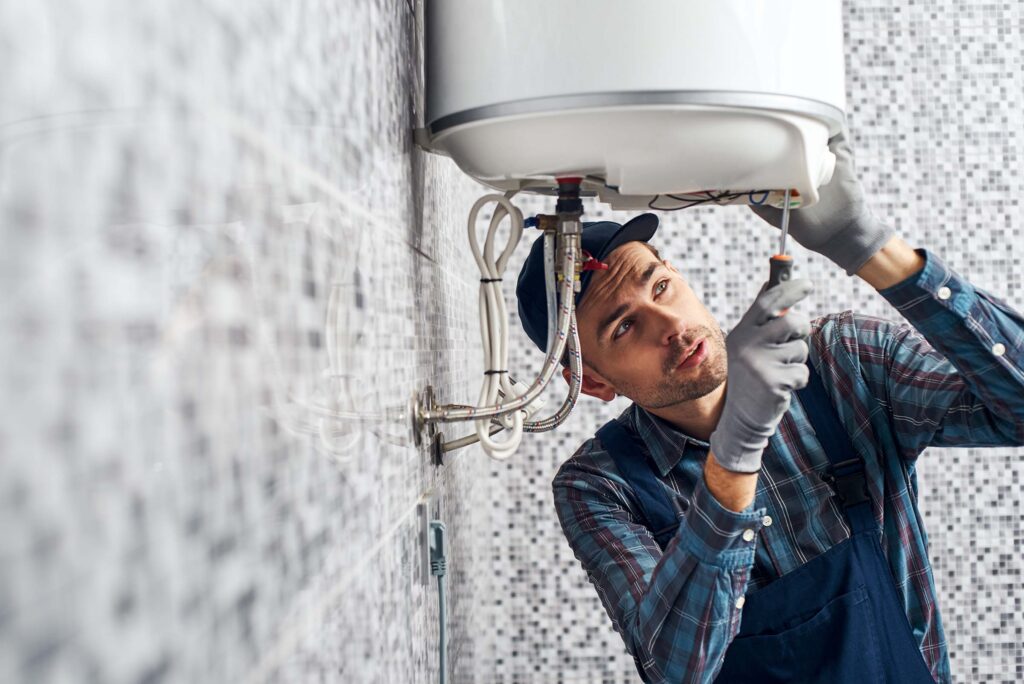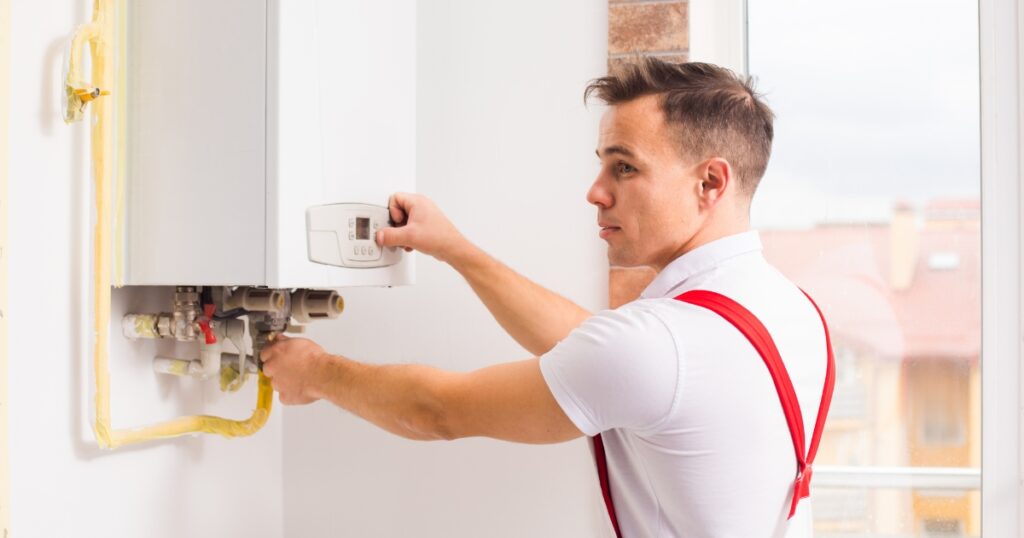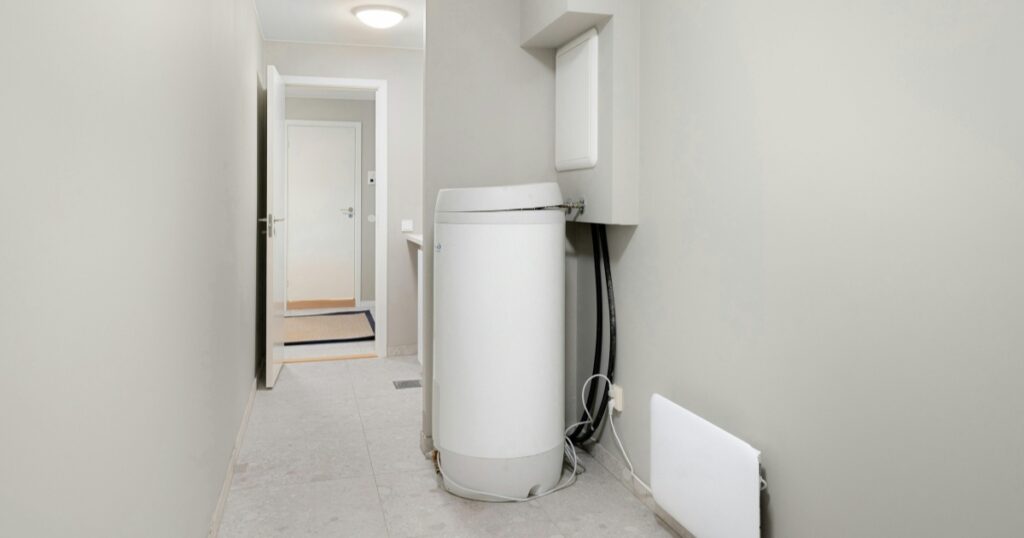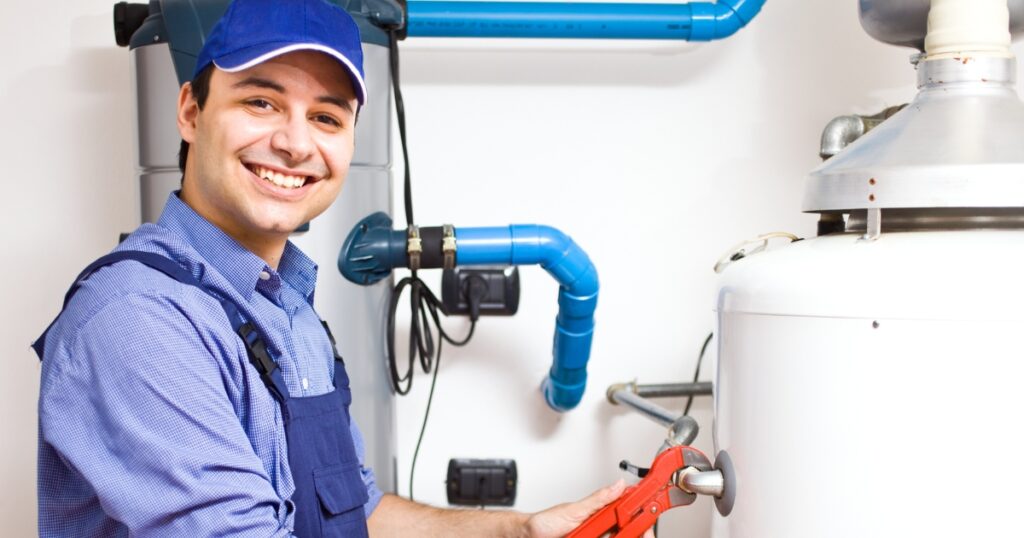Ever found yourself standing in the shower with goosebumps, rather than steam? Yeah, it’s not a good start to the day. We get that having hot water at the ready is pretty much essential in any Aussie home.
Especially since that cheeky pilot light plays such a big role in keeping things toasty! We’ve done our homework and scoured all sorts of info so you won’t have to shiver through another unexpected cold spell.
Our guide zeroes in on common snags your heater might hit – particularly with that tricky burner assembly – and we’re chuffed to share some ace troubleshooting tips with you. Stick around, because we’re about to help sort out your hot water hitches once and for all!
Key Takeaways
- The hot water heater burner assembly consists of crucial components such as the pilot assembly, gas control valve, thermostat, and burner, all working together to heat the water in your tank efficiently.
- Common issues with the burner assembly include malfunctioning pilot lights, clogged or dirty burner components, gas supply problems, improper combustion due to air intake/exhaust system faults, and potential safety risks from gas leaks.
- To diagnose problems with the burner assembly: inspect the pilot light, observe burner operation and flame characteristics; check for gas leaks using soapy water solution; test thermocouple functionality; verify gas control valve operation; monitor system cycling and measure temperature differentials between areas of the water heater.
Common Hot Water Heater Problems and How to Identify Them
- Water Temperature Issues: If the water is not getting hot enough, or if it’s too hot, there could be a problem with the thermostat or heating element.
- Discoloured/Smelly Water: Rusty or smelly water could indicate corrosion inside the tank or bacteria growth.
- Noises From the Water Heater: Strange noises such as banging, popping or rumbling could be caused by sediment buildup in the tank.
- Leaks from the Water Heater: Any visible leaks around the tank could signal a serious issue and should be addressed immediately.
Water Temperature Issues
So, you’ve noticed your hot water isn’t as hot as it should be, or maybe it’s too hot. We know how frustrating this can be. First things first, let’s look at the thermostat on your system—it controls when the heating element or gas burner kicks in to heat the water.
If it’s not set correctly or malfunctioning, that could be why you’re having temperature problems.
Make sure your heater is set to the right temperature – around 120 degrees Fahrenheit is generally recommended for both comfort and safety. If adjusting the thermostat doesn’t fix the issue, then there might be a more complex problem with the heating elements themselves or a faulty thermocouple within your system.
These components are crucial because they directly affect how much heat is generated inside your tank.
Now that we’ve tackled water temperature issues, let’s dive into another common concern: discoloured or smelly water coming from your taps.
Discoloured/Smelly Water
If you notice discoloured or smelly water coming from your hot water taps, it could be an indication of sediment buildup or bacterial growth inside the water heater tank. Sediment buildup is common in areas with hard water and can cause the water to appear discoloured or to have a metallic taste.
Bacterial growth can occur when the temperature of the water heater is set too low, leading to a foul smell emanating from the hot water.
Regular maintenance and flushing of your hot water heater can help prevent these issues. Flushing involves draining and cleaning out the tank to remove sediment and bacteria, ensuring that you enjoy clean, fresh-smelling hot water.
You should also consider checking the thermostat settings on your hot water heater and adjusting them if necessary to prevent bacterial growth. By keeping up with regular maintenance tasks, you can ensure that your hot water stays clean and fresh-tasting for everyday use.
Noises From the Water Heater
Noises from the water heater can indicate a range of issues, such as sediment buildup, loose heating elements, or excess pressure inside the tank. These sounds may present as popping, banging, or gurgling noises and can be concerning for homeowners.
Ignoring these noises could lead to further damage to the water heater system.
Regular maintenance of your water heater can help prevent these noises and ensure efficient operation. Flushing the tank annually to remove sediment buildup and checking plumbing connections for any leaks can help address potential causes of noisy operation.
If left unaddressed, these issues could result in more significant repairs or even premature failure of your water heater system.
Leaks from the Water Heater
If you notice water pooling around your water heater or discover dampness on the floor nearby, there may be a leak in the water tank. A leaking hot water tank can lead to significant damage and higher energy bills.
It’s important to act quickly if you suspect a leak, as this could be due to corrosion or a faulty temperature and pressure relief valve. Regular inspection of your hot water system is crucial for identifying leaks early and preventing potential damage.
Detecting leaks from the water heater requires a thorough visual examination and may also involve checking for moisture accumulation or rust on the tank itself. Addressing leaks promptly can prevent further issues with your hot water system, ensuring it continues to function efficiently and reliably.
Understanding the Hot Water Heater Burner Assembly
The hot water heater burner assembly consists of several components that work together to heat the water. To learn more about how it works and common issues, keep reading!

Components of a hot water heater burner assembly
The burner assembly of a hot water heater consists of several essential components that work together to heat the water in your tank efficiently. Understanding these components can help you identify issues and perform basic maintenance. Here are the key parts of a hot water heater burner assembly:
- Pilot Assembly: This component serves as the ignition source for the burner, providing the initial flame to ignite the gas when heating water.
- Gas Control Valve: The gas control valve regulates the flow of gas to the burner, controlling the temperature of the water by adjusting the burner’s heat output.
- Thermostat: Connected to test the temperature of the water, this device controls when the element or gas burner is turned on and off to maintain a consistent temperature.
- Burner: The burner is responsible for actually heating the water as it passes through, and any issues with it can lead to inconsistent water temperatures or no hot water at all.
How it works
Understanding how the hot water heater burner assembly works is essential for diagnosing and repairing any issues with your water heater. The pilot assembly, which serves as the ignition source for the gas burner, ignites to heat the water inside the tank when temperature adjustments are needed.
The thermostat attached to test and regulate the element or gas burner ensures that the water reaches and stays at a desirable temperature. It’s crucial to comprehend these components of a hot water heater in order to effectively troubleshoot problems with the burner assembly.
The operation of a hot water heater involves several components working together seamlessly. The pilot assembly provides an initial spark, while the thermostat monitors and regulates the temperature of the water, ultimately ensuring a consistent supply of hot water.
Common issues with the burner assembly
After understanding how a hot water heater’s burner assembly works, it is crucial to be aware of common issues that may arise. The most frequent problems with the burner assembly include a malfunctioning pilot light, clogged or dirty burner components, and gas supply issues.
These can lead to inadequate heating and even result in no hot water at all. Additionally, improper combustion caused by a faulty air intake or exhaust system can impact the efficiency of the burner assembly, leading to further complications for the entire hot water heater system.
Homeowners must also keep an eye out for any signs of gas leaks around the burner assembly as they pose serious safety risks. It’s essential to address these issues promptly to ensure both optimal performance and safety when dealing with a hot water heater’s burner assembly.
Diagnosing and Repairing Hot Water Heater Burner Assembly Issues
To diagnose a problem with the burner assembly, start by checking for any visible signs of damage or corrosion. Then, test the gas supply and pilot light to ensure they are functioning properly.
If there are issues with the burner assembly, common repairs may include cleaning or replacing components, adjusting the air-to-fuel ratio, or fixing any gas line leaks.
Steps to diagnose a problem with the burner assembly
We first ensure that the gas or electricity supply to the water heater is turned off. Then, we follow these steps to diagnose a problem with the burner assembly:
- Inspect the Pilot Light: Check if the pilot light is out or if it’s flickering. A steady blue flame indicates proper functionality.
- Observe Burner Operation: Turn on the water heater and observe whether the burner ignites, burns steadily, and then turns off when it reaches the set temperature.
- Check for Gas Leaks: Use a soapy water solution to check for gas leaks around the connections and fittings of the burner assembly.
- Test Thermocouple Functionality: Ensure that the thermocouple is properly positioned in relation to the pilot light and measures an appropriate temperature when heated.
- Verify Gas Control Valve: Make sure that the gas control valve is functioning correctly by testing its ability to regulate gas flow to the burner assembly.
- Inspect Burner Assembly Components: Examine all components of the burner assembly for signs of corrosion, damage, or debris accumulation.
- Measure Temperature Differential: Use a thermometer to measure temperature differentials between areas of the water heater, including input and output pipe temperatures.
- Assess Combustion Air Supply: Check for obstructions or insufficient airflow in the combustion chamber and venting system that might affect burner operation.
- Gauge Flame Characteristics: Observe flame characteristics such as colour, size, and shape while taking note of any sputtering or unusual sounds during operation.
- Monitor System Cycling: Pay attention to how frequently and consistently the burner assembly cycles on and off during normal hot water usage patterns.
Common repairs for the burner assembly
The burner assembly of a hot water heater can experience issues that may require repairs. Understanding these common repairs can help you troubleshoot and resolve problems with your hot water heater. Here are the common repairs for the burner assembly:
- Clean the burner: Over time, dust and debris can accumulate on the burner, affecting its performance. Cleaning the burner with a soft brush or cloth can improve its efficiency.
- Check and adjust the air shutter: The air shutter controls the amount of oxygen that reaches the burner. If it’s not properly adjusted, it can affect the flame quality. Ensure it is clean and set to the manufacturer’s specifications.
- Inspect and replace the thermocouple: A faulty thermocouple can cause issues with the pilot light and burner operation. Inspect for any damage or wear and replace if necessary.
- Test and replace the gas control valve: If you suspect an issue with the gas control valve, test it according to manufacturer guidelines using a multimeter, and replace it if found faulty.
- Clear obstructions from the pilot assembly: Ensure there are no obstructions in the pilot assembly that could interfere with ignition or flame stability.
- Verify proper gas pressure: Low or fluctuating gas pressure can impact burner performance. Consult a professional to verify and adjust gas pressure if needed.

Other Reasons for Hot Water Heater Malfunctions
Broken heating element
A broken heating element in a hot water heater can result in insufficient or no hot water. We can identify this issue when the water fails to heat up despite the system running.
This problem often requires professional repair or replacement, as fixing a broken heating element typically involves technical expertise and specific tools.
Faulty electric elements are more common among older systems, and it’s essential to inspect them regularly for signs of wear or damage. Regular maintenance check-ups by a licensed technician can help extend the lifespan of your heating element, ensuring that you have reliable access to hot water at all times.
Faulty gas control valve
Transitioning from the topic of a broken heating element, it’s important to understand the potential issues related to a faulty gas control valve in your hot water heater. The gas control valve is responsible for regulating the flow of gas to the burner assembly, ensuring that the water heater operates efficiently and effectively.
A faulty gas control valve can lead to problems such as inconsistent water temperature, no hot water at all, or even complete system failure. It’s essential for homeowners to be aware of these potential issues so that they can take appropriate action if they suspect a problem with their hot water heater’s gas control valve.
Regular maintenance and prompt repair or replacement, when needed, are crucial in preventing disruptions to your access to hot water.
Pilot light issues
If the pilot light on your hot water heater is frequently going out, it could be due to a dirty or clogged pilot assembly. A common cause for this issue is a buildup of dirt, dust, or even spiderwebs in the area surrounding the pilot light.
It’s essential to ensure that the area around the pilot light is kept clean and free from any obstructions to prevent recurring issues with the pilot light going out.
Another possible reason for pilot light problems could be a faulty thermocouple. The thermocouple plays a crucial role in sensing if the pilot flame is lit, and when it malfunctions, it can lead to recurrent issues with the pilot light going out.
If you encounter persistent problems with your hot water heater’s pilot light, it may be necessary to seek professional assistance for an accurate diagnosis and repair.
When to Contact a Professional and Tips for Preventing Future Hot Water Heater Problems
In conclusion, knowing when to seek professional help for hot water heater issues is crucial. Regular maintenance and inspections can prevent problems in the future. Being proactive can save time, money, and hassle down the line.
Professionals are there to help with complex issues or repairs that are beyond your scope. It’s essential to address any burner assembly issues promptly to ensure your hot water heater functions efficiently.






